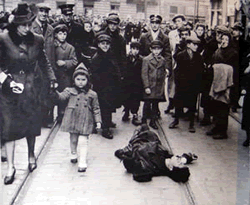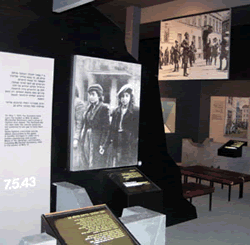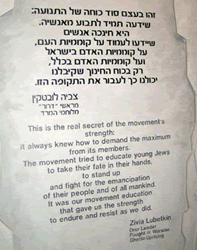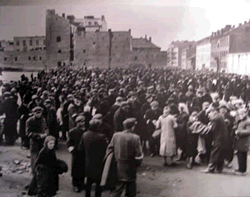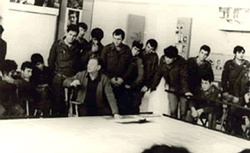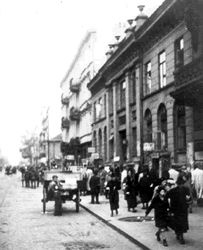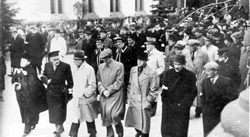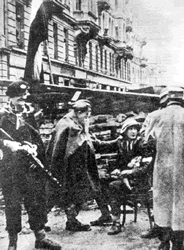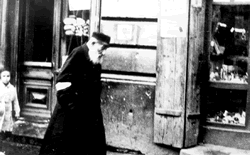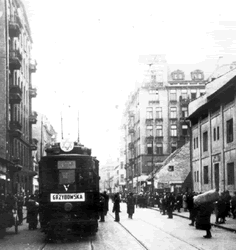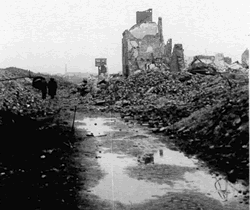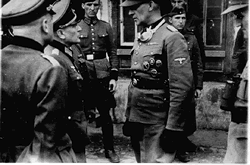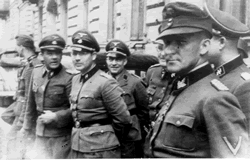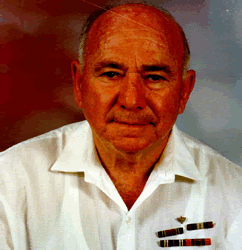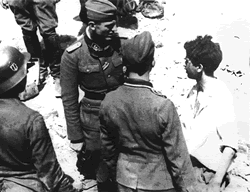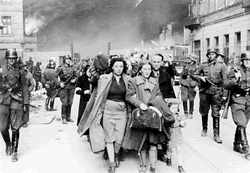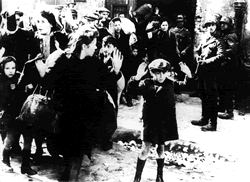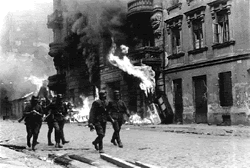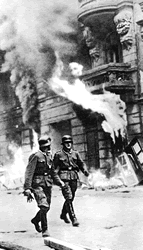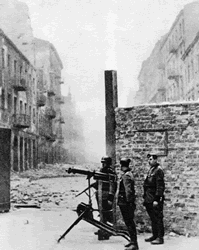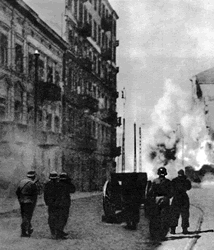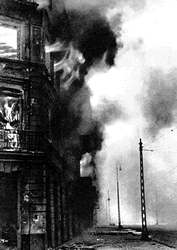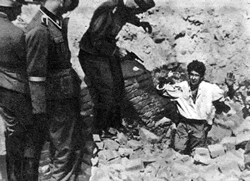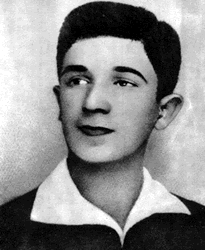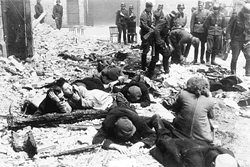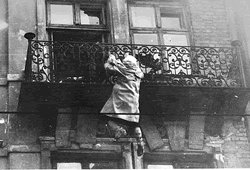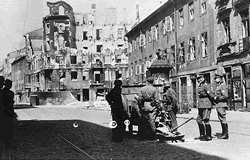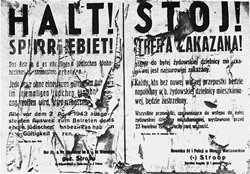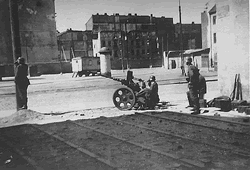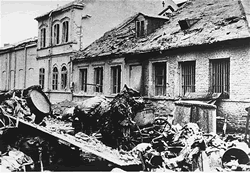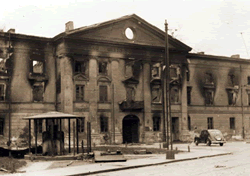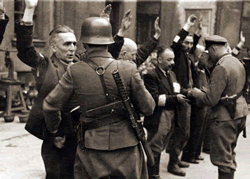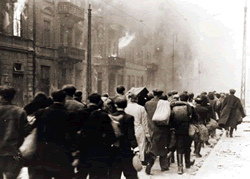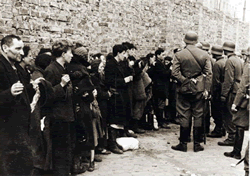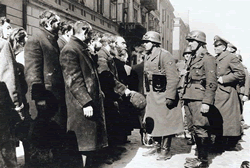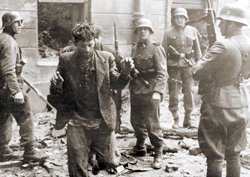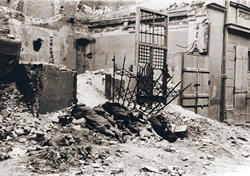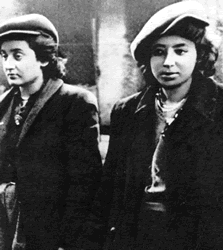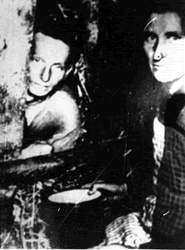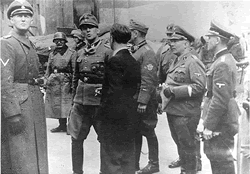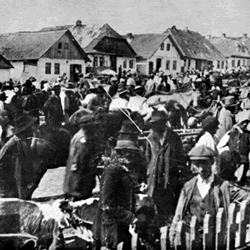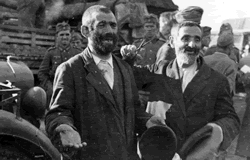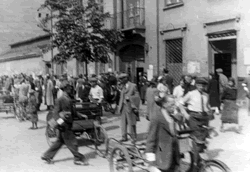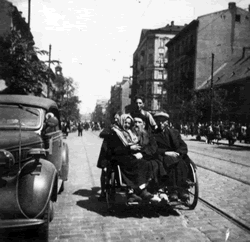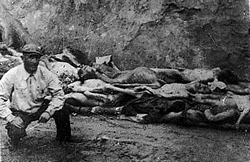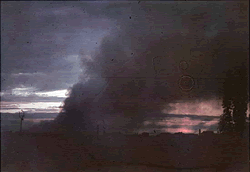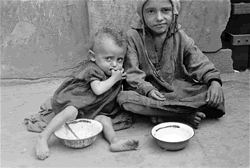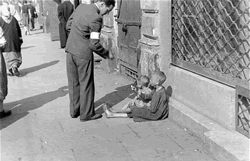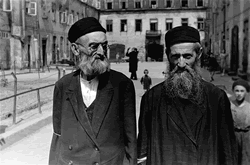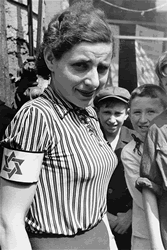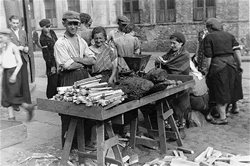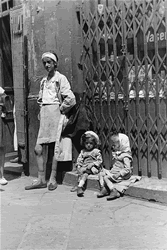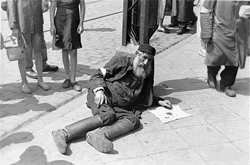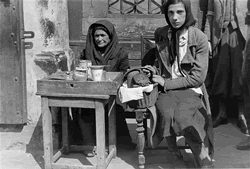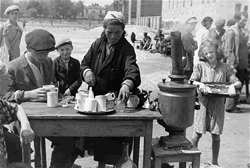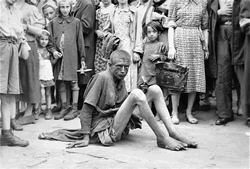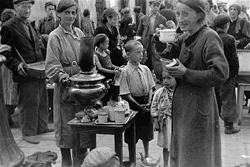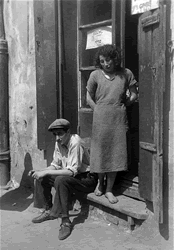| For #wrsw_gs-a: to #wrsw_gs-e: This exhibition, devoted to the Jewish uprising in the Warsaw Beside the exhibition hall is a screening room for viewing a film on Model of the Warsaw Ghetto |
|
#wrsw_gs-a: The Warsaw Ghetto Fights Back" |
#wrsw_gs-b: The Warsaw Ghetto Fights Back" |
#wrsw_gs-c: The Warsaw Ghetto Fights Back" |
#wrsw_gs-d: The Warsaw Ghetto Fights Back" |
#wrsw_gs-e: Antek Zuckerman explaining the Warsaw ghetto model to IDF |
|
|
#wrsw_gs-1: |
#wrsw_gs-2: |
|
#wrsw_gs-3: |
#wrsw_gs-4: |
|
#wrsw_gs-5: |
#wrsw_gs-6: |
|
#wrsw_gs-7: |
#wrsw_gs-8: |
|
#wrsw_gs-9: The Warsaw Ghetto Uprising |
#wrsw_gs-10: The Warsaw Ghetto Uprising captions and credits #wrsw_gs-10 to #wrsw_gs-35 go to http://www.fcit.usf.edu/holocaust SS officers interrogate a captured resistance fighter during the Warsaw Ghetto Uprising, which began on April 19, 1943, and ended on May 16, 1943. SS troops suppressed the uprising under the command of General Jürgen Stroop. |
|
#wrsw_gs-11: The Warsaw Ghetto Uprising Jews captured during the Warsaw Ghetto Uprising are led by German soldiers to the assembly point for deportation. |
#wrsw_gs-12: The Warsaw Ghetto Uprising One of the most famous pictures of the Holocaust. German storm troopers force Warsaw ghetto dwellers of all ages to move, hands up, during the Warsaw Ghetto Uprising in April-May 1943. |
|
#wrsw_gs-13: The Warsaw Ghetto Uprising The April 28 edition of the Voice of Warsaw (a publication of the Warsaw Committee of the Polish Workers' Party) reported, "The SS thugs set ablaze entire blocks of flats in order to force the population to come out of hiding...the water, gas, and electric supplies were cut off...." |
#wrsw_gs-14: The Warsaw Ghetto Uprising Close-up of previous photograph. |
| #wrsw_gs-15: The Warsaw Ghetto Uprising Nazis guard an opening in the ghetto wall with a machine gun during the Warsaw Ghetto Uprising, 1943. |
#wrsw_gs-16: The Warsaw Ghetto Uprising The Warsaw ghetto, April 1943. |
#wrsw_gs-17: The Warsaw Ghetto Uprising Destruction of the ghetto was a primary Nazi strategy to squelch the Warsaw Ghetto Uprising in April-May 1943. |
#wrsw_gs-18: The Warsaw Ghetto Uprising The SS-men lay in wait for the fighters and civilians forced out of their bunkers by fire, gas, and a lack of water. |
#wrsw_gs-19: The Warsaw Ghetto Uprising Mordechai Anielewicz (1919-1943), commandant of the ZOB during the Warsaw Ghetto Uprising. He fell in battle on May 8, 1943. |
#wrsw_gs-20: The Warsaw Ghetto Uprising Jews are found in a bunker during the Warsaw Ghetto Uprising in May 1943. |
#wrsw_gs-21: The Warsaw Ghetto Uprising A woman hangs from a balcony, preparing to drop to the street and the waiting SS. |
#wrsw_gs-22: The Warsaw Ghetto Uprising A German gun crew prepares to shell the ruins of a building during the suppression of the Warsaw Ghetto Uprising. |
#wrsw_gs-23: The Warsaw Ghetto Uprising An announcement posted several days after the beginning of the Warsaw Ghetto Uprising on the order of SS Major General Jürgen Stroop which forbids entrance to the ghetto under punishment of death. |
#wrsw_gs-24: The Warsaw Ghetto Uprising A German gun crew in action during the suppression of the Warsaw Ghetto Uprising. |
#wrsw_gs-25: The Warsaw Ghetto Uprising Debris litters the street in front of a building destroyed by the SS during the suppression of the Warsaw Ghetto Uprising. |
#wrsw_gs-26: The Warsaw Ghetto Uprising The ruins of the former Warsaw ghetto Jewish Council building after its destruction by the SS during the ghetto uprising. The original German caption reads "The building of the former Jewish Council." |
#wrsw_gs-27: The Warsaw Ghetto Uprising SS troops and officers search the Jewish department heads of the Brauer armaments factory during the suppression of the Warsaw Ghetto Uprising. |
#wrsw_gs-28: The Warsaw Ghetto Uprising Jews captured during the Warsaw Ghetto Uprising are marched off through a debris-covered street to the Umschlagplatz for deportation. |
#wrsw_gs-29: The Warsaw Ghetto Uprising Jews captured by the SS during the Warsaw Ghetto Uprising are interrogated beside the ghetto wall before being sent to the Umschlagplatz. The original German caption reads: "Search and Interrogation." |
#wrsw_gs-30: The Warsaw Ghetto Uprising An SS Sergeant (Oberscharführer) interrogates religious Jews captured during the suppression of the Warsaw Ghetto Uprising. The original German caption reads: "Jewish rabbis." |
#wrsw_gs-31: The Warsaw Ghetto Uprising SS assault troops capture two Jewish resistance fighters pulled from a bunker during the suppression of the Warsaw Ghetto Uprising. The original German caption reads alternately: "Pulled from a bunker" or "Bandits." |
#wrsw_gs-32: The Warsaw Ghetto Uprising The bodies of Jewish resisters lie in front of the ruins of a building where they were were shot by the SS during the suppression of the Warsaw Ghetto Uprising. The original German caption reads: "Bandits killed in battle." |
#wrsw_gs-33: The Warsaw Ghetto Uprising These two women, soon to be executed, were members of the Jewish resistance. Dispatches by SS and Police General J. Stroop reported that "...Jews and Jewesses shot from two pistols at the same time....The Jewesses carried loaded pistols in their clothing with the safety catches off....At the last moment, they would pull hand grenades out...and throw them at the soldiers...." |
#wrsw_gs-34: The Warsaw Ghetto Uprising The Warsaw Ghetto Uprising (April 19-May 16, 1943) was the twenty-day battle initiated by the Jewish fighting forces in Warsaw when German troops entered the ghetto to begin the final round of deportations. |
| #wrsw_gs-35: The Warsaw Ghetto Uprising SS Major General Jürgen Stroop (second from left) gathers information from a civilian on the second day of the suppression of the Warsaw Ghetto Uprising. |
#wrsw_gs-36: |
#wrsw_gs-37: |
#wrsw_gs-38: |
#wrsw_gs-39: |
#wrsw_gs-40: Burial of corpses from the Warsaw ghetto; cemetery on Okopowa Street |
#wrsw_gs-41: The Warsaw Ghetto in flames, April 1943. I believe this to be the only color photograph showing the Warsaw Ghetto in flames during the 1943 uprising. It was made as a transparency by my late father-in-law, Karol Grabski of Ldz, who was hiding in Warsaw at the time." Jacek Jurczakowski, Ldz |
#wrsw_gs-42: |
#wrsw_gs-43: |
#wrsw_gs-44: |
#wrsw_gs-45: |
#wrsw_gs-46: |
#wrsw_gs-47: |
#wrsw_gs-48: |
#wrsw_gs-49: |
#wrsw_gs-50: |
#wrsw_gs-51: |
#wrsw_gs-52: |
#wrsw_gs-53: |
#wrsw_gs-54: |
#wrsw_gs-55: |
#wrsw_gs-56: |
|
|
|
VOICES FROM THE INFERNO
HOLOCAUST SURVIVORS DESCRIBE THE LAST MONTHS IN THE WARSAW GHETTO
Warsaw Ghetto: The End - yadvashem.org
www.yadvashem.org/warsaw_ghetto
Video testimonies about the final months of the Warsaw Ghetto
http://www.yadvashem.org/yv/en/exhibitions/warsaw_ghetto_testimonies/index.asp?WT.mc_id=200960&WT.cg_n=g.en&gclid=CjwKEAjwwcjGBRDj-P7TwcinyBkSJADymblTtCnTLWkKgDHn9IB-W6zRZpmxT1Ui4v3N1rGaEhiDQRoCEhLw_wcB
--
This exhibition brings together excerpts from many hours of video testimony given by the survivors of the Warsaw Ghetto and former combatants in the uprising. Some of the Jews of the ghetto succeeded in escaping the ghetto after the battle that raged there and survived in hiding on the Aryan side, under an assumed identity or in the forests. Others hid deep inside the bunkers in the ghetto, but were ultimately discovered by the Germans and deported to concentration and death camps. There were also the few who managed to survive among the ruins of the ghetto until the liberation. The majority of the Jews who took part in the Warsaw Ghetto uprising were murdered, whether during the brutal suppression of the uprising, while attempting to escape the burning ghetto, in the camps or on the Aryan side. Few survived the inferno; some of their testimonies are presented here.
This unique oral documentation enables us to shed new light on the fate of the Jews in the Warsaw Ghetto during the uprising thereby enhancing our understanding of one of the central chapters in Holocaust history.
List of Rabbis from the Warsaw Ghetto (in Hebrew) Download PDF
From: Yoel Rosenfeld <jrose@kenscap.com>
